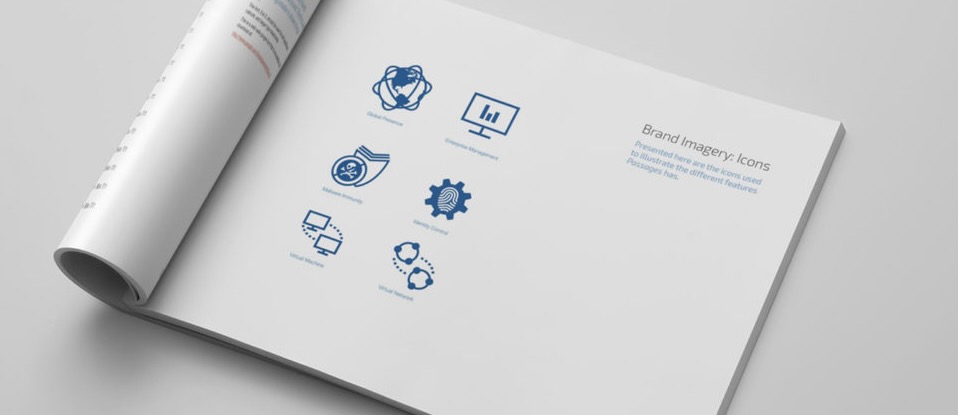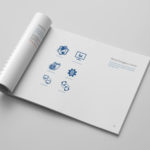Five Characteristics of a Brand Style Guide

What makes a brand compelling? Identifiable? Cool? Inspiring?
Well-crafted and maintained brands balance many factors in the pursuit of communicating and resonating with people and ultimately compelling them to action. A good brand embodies several key elements (among others):
- Soul
- Mission
- Purpose
- Originality
- Simplicity
- Consistency
Without consistency, your brand has no stability. There is no anchor to keep your audience engaged. Consistency moves your prospects to take notice every time they see an ad, receive an email, or come across a landing page. Without consistency, you are working against yourself and, in some ways, you become your own strongest competitor.
Your brand guide will help ensure the consistency of your brand presentations.
Buying has always been an emotional experience. A fact-filled sales deck is no longer enough to close deals. That deck must accurately communicate the look you’ve nurtured inside your organization and help your prospect feel what it will be like to work with you. And the person creating the deck needs to be empowered to make it happen.
Without consistency, your brand has no stability.
Yet for many organizations prioritizing and maintaining a strong sense of brand consistency is a struggle. Your copywriters and designers don’t have the capacity to bring everything you produce into alignment or respond to all the external requests for assets. You may not even have those skill players on your payroll—mostly working with a distributed network of contractors and company stakeholders to produce your branded collateral.
Brand sense is also becoming more important in the sales and customer retention processes. As the buyers’ table gets younger, the need increases for B2C-style interactions with your prospects. The digital natives who make up a portion of your buying audience are also brand natives.
They’ve grown up in a time when everything is a brand. They have been continuously exposed to excellent and well-expressed brand impressions. If you want to be a front runner in your market, your brand look and feel must be compelling and consistent to compete.
For HealthTech SaaS companies, this struggle is a common story.
Producing an effective style guide for your company will provide your employees—especially those who communicate with potential customers—the tools and parameters they need to effectively create digital or printed expressions of your brand.
The Fundamentals of a Brand Style Guide
There are dozens of templates and examples of brand guides online if you want your internal team to build or refresh one yourself. If you work with an agency to build or revitalize your branding, they will likely produce a guide for you as part of your work with them.
In the new reality of remote work there are all kinds of solutions popping up to help your distributed team maintain brand consistency without the physical proximity.
Regardless of the path you choose, all solutions serve the same general purpose; empower your team to maintain vital brand consistency.
But in order to talk about how a brand guide can help you, we must first agree on the scope of what we’re talking about.
A functional brand guide contains the following:
- Your company name and tagline. How they are expressed together and, if applicable, separately.
- Who your company is and what it does; your top-line positioning language.
- Who your audience is, and an accurate representation of the problem they are facing that you can help them solve.
- Your voice; the tone that governs your written language.
- Your logo and instructions for its presentation; including sizes, dimensions, colors, vertical and horizontal display options, clear space requirements etc.).
- Color palette; including CMYK, Hex, RGB, and PMS (Pantone Matching System) information. How the colors work together, and a general spatial hierarchy.
- Typography system and general guidelines for use.
- Photography, icon, and illustration styles.
- Examples of different digital and print applications of the brand
- Any instructions for troublesome applications of the brand (like embroidered on a cap).
- Company-specific instructions to empower your specific team with what they need.
The Size and Specificity of Your Style Guide Depends on the Answers to Two Questions
How big is your company?
Smaller companies typically have stronger stakeholder oversight and are able to keep a closer eye on consistency, but still need to be empowered with general norms and guidelines. Large companies tend to have much less stakeholder oversight and a much higher volume of asset production. These organizations typically need a larger, more specific and prescriptive guide to ensure effective team empowerment.
Who Communicates on Behalf of the Brand?
Some companies have very few team members who create communication pieces for outside consumption. Others have digital templates for all touchpoints. But if many different people in different departments and roles will be creating band impressions, a guide is essential.
Five Characteristics of a Successful Style Guide
A style guide that is created and not used is a waste of time, energy, and money. A guide that is too complicated and legalistic won’t be used correctly and create angst in your organization. A usable and effective style guide is accessible, consistent, intentional, flexible, and scalable. You can empower your team to create positive brand impressions.
Accessible
Your copywriters and graphic designers rely on your style guide to keep the brand consistent, but they’re not the only ones who need it. Your guide is also for the sales executive who needs to create a personalized proposal or the department administrator who needs to print t-shirts for a retreat.
If your brand guide is complicated and difficult to access, your employees might become frustrated and choose to come up with their own expressions of your brand diluting what you’re trying to accomplish. Include diagrams for usage and instructions for non-designer applications. If it is simple enough to understand and practical enough for them to apply, you’ve won the day.
If your guide is easy to navigate (intuitive and interlinked index) and simple to follow (written in plain English, quick links to helpful resources, etc.), your marketing team will have less nitty-gritty police work to keep the brand on target. Plus, there will be positive internal peer pressure throughout your entire company to show the brand correctly because the guidelines are easily accessed and understood by all.
Finally, make sure your brand guide is physically easy to find. Make sure it’s an intuitive spot in your file system, company wiki, or website. A buried brand guide will serve no one.
Consistent
Your brand guide must be the single source of truth when it comes to your brand. If every employee adheres to these guidelines and parameters, everything newly created will be consistent with everything that has been released in the past.
The strength of your brand is not in how cool your logo is. It is in your consistency across multiple contexts and channels. When your prospect sees that ad, gets that email, and navigates to that landing page, the close adherence to brand guidelines used to craft those touchpoints should result in a cohesive, established, trustworthy experience (with relatively little effort).
Sales cycles in the B2B Healthcare technology ecosystem are long. Some on your team may become bored with how the brand is being used and shown. Help them see that although they may have seen the logo 10,000 times, your prospective customer is just beginning to identify it. The more consistently applied the more weight your brand will carry over time.
Your brand guide must be the single source of truth when it comes to your brand.
Intentional
Your brand is not about you. Your brand is about your audience and designed with them in mind. It prompts thinking and a feeling response from them.
But the larger your organization, the more opinions you will hear about your brand.
Your staff’s opinions are important because your team must believe in the brand they represent, but if the opinions cause you to make changes and lose your focus on your customer, your company ultimately loses.
You’re not marketing to your staff, your stakeholders, or your investors. You’re marketing to your audience. To the people who make purchasing decisions.
Reserve a portion of your style guide, or at least a portion of your launch presentation, to remind everyone of the connective tissue between your brand, your solution, and your customer. This intentionality will quiet many voices and help you remain focused on the main thing.
When your team understands why something is the way it is, they’ll do a better job of holding fast to the guidelines.
Flexible
Conversely, your brand guideline should not paint you into a corner. While consistency and intentionality are vital, it is also important to be realistic about all of the things that your brand needs to do in the wild. You should have multiple ways to effectively express your brand in a variety of different mediums sizes and contexts.
This means that your type system in color treatments and corresponding guidelines should be flexible enough to accommodate a variety of challenges. This means that concepts like “general visual hierarchy” are more important than “strict prescriptive sizing.” When considering your brand voice guidelines, consider using guiding principles as opposed to specific words.
If your brand guidelines are flexible enough to accommodate a wide variety of settings, the likelihood of your team maintaining those guidelines over time is much higher as they will not need to be broken to meet specific, real-life criteria.
Scalable
Your brand will grow and mature alongside your company, and because of that, your brand guidelines are not a one-and-done effort. If you hire an agency to create your brand guidelines make sure that they will deliver the art files or editing access for the deliverable.
Create a consistent quarterly or annual pulse to audit, assess, update and add to your guidelines. Make sure it is a living document that matures alongside your organization, as the use cases, people, and problems you encounter shift and change with time.
Your Brand is an Investment- Guard It Well.
Without an established guide, your brand—which you painstakingly and purposefully created—will get picked at, tweaked, and diluted until it has lost all integrity and meaning. So, make sure you get the most out of your investment by creating a brand guide, getting stakeholders’ approval, and watching your company’s brand recognition and credibility grow in the years to come.
Interested in learning how Golden Spiral can help with your brand? Contact us today and learn more about our programmatic activities.


